I spoke with OneGo about their offering. I still had questions about the business structure and was able to setup a phone call with their CEO, Paulius Grigas.
If you are considering booking travel or signing up for a new credit card please click here. Both support LiveAndLetsFly.com.
If you haven’t followed us on Facebook or Instagram, add us today.
UPDATE – The company clarified that to this point OneGo has not sought Venture Capital investments. In my previous version, I had stated that the company had “not successfully raised venture capital funds” which is true. They haven’t. But they have not yet opened a round either (something I was unaware of at the time of publication) and writing that they had not successfully raised could have been interpreted that they attempted to raise and failed. They have not, and I am happy to update the piece accordingly for accuracy.
Too Good To Be True?
OneGo got a lot of press last week about their new subscription service model and I was admittedly curious about whether or not this could be a good service for myself or our readers, especially for the purpose of re-qualifying for status. Here are the basics of the program:
- Pick a region (West, Central, East or Nationwide) – prices range from $1500 to $2950 per month
- You can have up to four ticketed reservations in your account at any time
- Must book 7 days prior
- Only valid for coach class
- Only valid for direct flights
- Uses revenue tickets from scheduled airlines
- Can choose your flight and carrier
Let’s assume you are an executive based in New York City with lots of weekly meetings throughout the month, you could easily attain a great deal of value from a OneGo subscription. Assuming for a second that you had offices on both coasts, this might be a lifesaver for you. But their business plan has serious holes which I will get to in a moment, and that causes me concern for a couple of reasons.
First, if the initial offer is for $1500 for example for unlimited west coast flights but after a couple of months they change the plan to be more like $2500/month, then it seems like a pain to start the program and then switch later. You also might feel like you are a victim of bait and switch to a certain degree, like if you sign up for a Netflix account and the membership price is $8/month for the first month with streaming and DVD rentals, and then jumps to $15 the next month. Second, is that if the business model is unsustainable then how will that effect my plans as a traveler, my ticketed reservations, etc.
But don’t worry, I have been assured the business plan is sound from none other than the CEO himself.
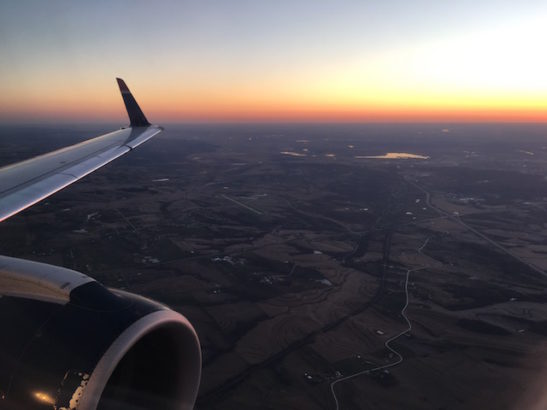
Who is OneGo targeting?
Huge multi-national corporations with big travel contracts who are spending hundreds of thousands of dollars monthly and the pockets to spend $2950/month per employee are not the targets for the business. Instead it’s small to medium-sized enterprises that make sense for OneGo. Businesses that have frequent travelers seeing clients and working with distributors face inconsistent travel expenditures, some months will be more expensive than others which makes planning and budgeting difficult. OneGo wants to make complicated budgeting and travel planning simpler for businesses like this, companies that spend about the amount of their subscription but don’t want to worry about costs and budget restrictions. They are not targeting huge companies nor consumers that would struggle to see value. Many of our UPGRD readers are consultants and could benefit from a more normalized travel budget (at least for flights).
But… How Will That Work?
Outside of small to medium-sized businesses that may want to normalize costs, they really don’t have much of a market. Why would I say that? Because you need clients that will be profitable, and outside of these clients I can’t see a way for OneGo to be profitable.
“We operate in a niche market” – Paulius Grigas, OneGo CEO
For example, if you are a huge corporation that flies executives back and forth from the coasts all the time this is probably a great deal for you and a terrible deal for OneGo. And if you are a consumer using the service for non-business purposes, you will almost undoubtedly be abusing the system, not because you have ill intent, but because this is how you would garner value. Which brings me to my next point…
What is the Business Proposition?
For a company or individual to buy this plan, to prepay their airfare for the month when they do not yet know their travel plans, they have to assume they will get more value out of it than the money they pay in. Based on that simple proposition how can OneGo make money? If I am a business owner and I am considering this plan, I would pull the last three months in business travel expenses, and look at the next month’s calendar. If the cost of the membership is cheaper than the money I would normally pay for airfare then it’s a good deal for me. But if it costs more than the business spends on airfare – why would I buy it?
You have to assume that almost any customer that buys a subscription is going to expect to save money otherwise they wouldn’t disburse the cash in advance knowing they would lose money. Why would anyone make a business decision where the principle idea is to lose money? It doesn’t make sense right?
Well… it does in the pretend world of startups. I say pretend because tech startups do not have to play by the rules of commerce and business norms in order to obtain massive funding and potentially succeed.
Let me offer some examples. Tesla has never had a profitable year, in 2014 they lost $294 million on $3.2 billion in revenue. They are hoping to be profitable in 2020, yet because they have a tech startup angle they don’t have to make money they just have to “get their business right”. Tesla’s stock opened in 2010 at $16 and at the time of writing closed at $174 per share with a market cap of $22 billion. How about Amazon with $313 million in profit between 2012 and 2013 combined and yet today the company has a market cap of $250 billion (which is down the last two weeks substantially)? Facebook for many years become a company worth billions of dollars without any real revenue and even posted losses. This is often explained by these type of businesses as imperative; building a user base is more important than making money, the profits will come later (though it isn’t looking so good for Twitter who followed the same model).
Compare that to being a local bakery and getting a loan from a bank. If your business plan doesn’t show sustainability by year three, you aren’t getting the money. And let’s say your new t-shirt shop acquires t-shirts for $5 and sells them for $4.50, there is no bank in the world that will approve that loan. Good luck finding a spouse to sign off on that plan too.
And yet we return to OneGo’s business model. OneGo has to believe that they will have some consumers that don’t buy more tickets than the cost of their subscription, but then still somehow will see enough value in the program to keep it the next month and months following. From day one there should be an expectation that every long term customer will be a loss for OneGo and every profitable customer will be unlikely to return.
I asked Paulius about this and he stated as much saying, “Some customers will be loss-making while others will be profitable.” He then went on to say that according to their research, in the end the business will be profitable.
It’s worth noting that unlike those other businesses, this one has bootstrapped the operation to date and has not yet successfully raised Venture Capital (they haven’t sought it at this point) which is a shame because it is always better to light someone else’s money on fire than your own.
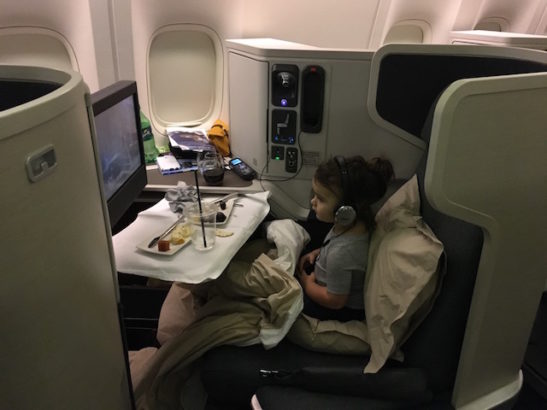
Revenue Tickets?
I got a chance to discuss some of these questions with the PR rep for OneGo and one of the first things I wanted to know was whether or not these were revenue tickets. It matters for UPGRD readers because our status, miles and upgrades are a top priority and make the many thankless trips across the country worth it in the long run. It would also make sense if these are not revenue tickets because using either distressed inventory, group inventory, or mileage redemptions would give OneGo a cost advantage over the normal cash price that you or I could buy from the airlines themselves. That would give them a chance to make some money on the sale of the tickets themselves.
The good news for consumers is that these are regular revenue tickets. They should be eligible for business incentive programs, frequent flyer miles, status based upgrades, miles, bonuses – they are no different than what you would find by going to the airline directly.
The bad news for OneGo is that because they do not have a cost advantage over larger distributors such as Expedia, and because airlines do not pay substantial commissions (between $2-15 per ticket, most are less if any) there is no possible way to make money by using abnormal inventory.
Why Else Does This Not Work?
Direct flights. You must book direct flights. On the east coast and in some hub cities this could work fine. Chicago, Houston Dallas, New York, Los Angeles, San Francisco – these cities are going to have no problem with this program. But what about that sales executive in Omaha, Austin, or Pittsburgh? Unless you can fly there direct, you are still stuck buying airfare on your own. Customers in Miami? Sorry Charlie, not for you. How about Pittsburgh to Seattle? Nope.
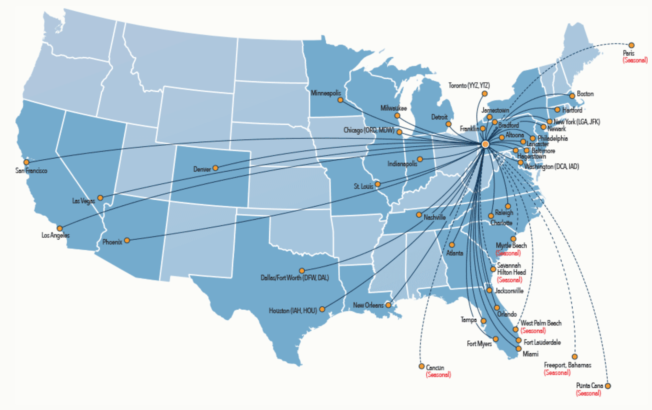
Image Credit: Pitairport.com
Pittsburgh is a middle-sized city and they don’t have direct flights to tons of big cities throughout the US, but smaller Austin is even tougher. Boise is somehow an option and possibly a profitable one for OneGo due to the fact that there are just 23 direct flight destinations from Boise and of those, two flights serve different airports in Chicago, and three of them are for different Bay Area airports. That’s 20 options and almost all of them are close by.
Kansas City isn’t even offered but Omaha (one third the size) somehow is.
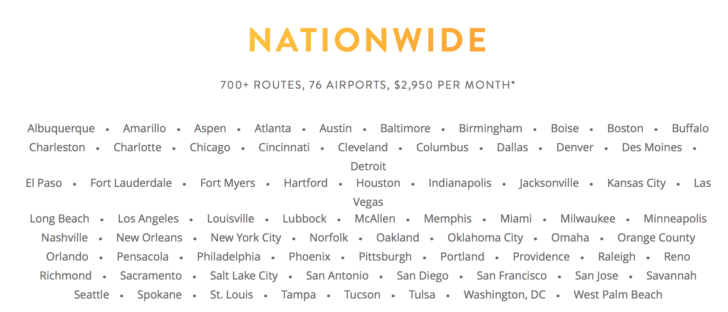
Image Credit: Onego.com
Here Is The Part Where Their Plan Defies Logic
Direct flights are often more expensive than flights with connections, so why not offer this as a choice? If OneGo wanted to give their business a fighting chance they could at minimum just have only given options for the cheapest available flight which may include connections. Travel managers for businesses might look at the expensive and specific direct flights their executives book spending thousands every month and think, “Hey we could save a lot by using this service.” Then once inside the program they would realize the flights are not direct and that represents the savings. This would force travel managers and business executives to make a decision about whether the company values cash or convenience more – probably to the flyer’s disappointment.
To the lay person, it might seem illogical for flights with a connection to be less expensive than direct flights because surely one flight is less expensive than two, but as we know this is not the case. It does beg the question, how familiar are these executives with travel? And if they are experienced in travel, I am guessing they aren’t big fans of “math”.
So I just went ahead and asked them. I laid out the above question and their CEO responded with something I can appreciate, “One of the goals [of OneGo’s service] is to provide direct flights, that’s what flyers want” – which is highly accurate.
Business travelers more than any other group desire direct flights. I was surprised that he put this restriction in place knowing it would likely be more expensive for OneGo every single flight but better for the customer. That is laudable. But is it profitable? Their models say it will be, I have my doubts.
I laid out a scenario of a sales rep in Pittsburgh (a member city) trying to get to Omaha (another member city) without direct flights. I pointed out that in order for this one trip to work you would need a minimum of two reservations but perhaps four depending on carrier and time. Pittsburgh to (connection city) and then separately (connection city) to Omaha and back. This would eat as little as half your available reservations for the month, but up to all of them if you can’t get carriers and routes that make sense.
“But then you also run the risk of not making your other flights because the airline will have no obligation to get you to your destination.” Mr. Grigas highlights another issue with direct flights that I had not considered yet which makes the direct flight an even tougher problem to solve.
Travel Experience
My theory is that someone came up with a great business problem that they wanted to solve with a technology startup. With an otherwise proven track record for success, why wouldn’t they be able to solve these problems, use a subscription model that has been successful for other businesses (Netflix, etc.)?
I asked who on the team had travel business experience. I was told the following: “They are all experts” – that is absolutely verbatim.
So, I looked up their team on Linkedin (a handful of members of OneGo appear on LinkedIn). Previous experience includes the following travel companies:
- Blackberry, Burger King, Kraft
- Ertico, Allianz, MetLife
- SellMeBooks
- (Professor) at several Middle Eastern Universities
- Stealth Travel
- United Airlines (2006-2008)
- American Express (New Product Development in their Global Business Travel department)
While the executive with American Express experience will likely have the connections to form significant business relationships for the company, I am uncertain as to whether or not that experience would allow for some of these obvious issues to become resolved. The manager for United had a revenue role, they should know better about connections and booking close-in to departure. The Stealth Travel business looks to be more of an IT support system and he probably helped with the development of the app and backend technology. Those three should definitely know about the travel space and what they are doing, the former United employee the most. But I am not sure being an expert in a business field without true travel experience for the others really works. I’m outside the nuts and bolts of the travel booking industry and from where I sit, it looks plain as day that this model has some serious problems.
There Is Also This…
The model doesn’t work because of the choices frequent flyers will make. The way the app works is by searching the date desired, departure and arrival city. Any direct flight between those markets will be offered, and because it is “all-you-can-fly” price does not appear.
Therefore, let’s assume that you prefer American Airlines and get upgrades accordingly flying from New York City to Los Angeles. You might have 20 different options (they all have to be direct which tend to be the most expensive than flights with a connection) but if American only had 5 seats left on the flight that fits your schedule, they might sell that ticket for $800-1000 in coach (remember this is as close as a week out). Let’s assume a competing Delta flight has 30 seats available at around the same time and is selling those seats for $400; if you don’t have status with Delta you are picking American every time, and for OneGo – that’s bad news. If it’s a weekly trip for an executive and that’s all the travel they do, OneGo is still losing between $250-1000 on that customer and there is no way they are making money.

Image Credit: Google.com/flights
But that is the whole point. OneGo is building their business on the expectation that subscribers will book flights that cost less than their subscription price. Their sales pitch is less about enhanced services for these customers, but rather a value proposition – “With every flight covered by a monthly fee, never worry about going over your travel budget.” (onego.com)
OneGo would point back to proprietary data that they could not share for obvious reasons (because everyone will be running out to copycat this business model of course) that projects that they will have customers that will be winners for the business and losers for the business. What I am postulating here is that the winners (those that spend less than their subscription on travel) will provide less profit than the money they are losing on customers that are exceeding the price of their subscriptions.
The customer expects to save on costly cancelations and last minute tickets and since the commitment is just month-to-month, if they are not saving money (or getting more in tickets under their subscription than they would have paid in cash booking trip by trip) – they will cancel.
I could talk about how many other programs like these have come and gone. Jet Blue tried this model the last couple of years whereby you could fly an unlimited amount of flights (with some rules) for between $499 and $699 per month depending on whether you could avoid flying on Fridays and Sundays. They killed it off and brought it back but we haven’t seen it in awhile so we would have to assume that it was not profitable for them or else they would have continued. Consider that for a moment though. It was too costly for JetBlue, who is simply filling marginal space on their own aircraft (their actual out of pocket cost would have been negligible) – and they didn’t have to buy the tickets from other airlines at market rate for cash. There have been others as well but I won’t get into it. The horse has been sufficiently beaten.
Current Subscribers
I asked about how many current subscribers they have (an easy opportunity to show how successful their model will be), but of course that information was proprietary.
CEO
I want to be really clear that the call I had with OneGo’s CEO was not intended to be confrontational. I lament that he might have interpreted my questions about his business model as such and for any impression I left contrary to understanding more about how the business would overcome these hurdles, I apologize. I do not want to cast the CEO, Paulius Grigas in a bad light. He is a smart guy (BA, MBA, JD) and he was passionate about his business. I can appreciate that.
That being said, this business (without having the proprietary information) seems problematic. As stated before, my concern is more about bait and switch with regards to current pricing and the model not working perfectly. I was told that additional options are being added soon (at an additional cost), that flights with connections may be available soon too though the date seemed unclear (maybe April). But the issue I had regarding the sustainability of the business itself remains, as connections were not added to make the business more viable, but rather to solve the other problems.
“Don’t worry about my business model, we will be around this month, next month” he alluded that my questions about the business model are irrelevant to whether or not the company is successful – what matters for me as a potential customer, is that I sign up and it works.
That’s a valid point. However, my sneaking suspicion is that it won’t work. I base that on being familiar with the travel industry (though not intimately involved on the business side) for over 15 years. Everything that has become untenable has fallen away, from lucrative miles and points schemes (US Airways Grand Slam, most mileage programs generally) to airlines that could not compete because their costs were too high and their prices too low. I don’t think that this business will last, however, if it does and it makes sense on a month-to-month basis, maybe I will become a subscriber.
Does anybody disagree? Did you try OneGo? How was your experience? Should other companies try this?

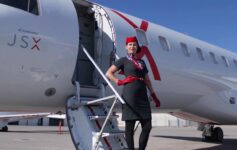


Very insightful piece. I also question the sustainability of this model.
Sure seems to me like the people most likely to use this service are also the most likely to game it for excess value. I share your skepticism that this will be sustainable.
Great read. I draw the same conclusions as you and haven’t been in the game as long. It’s striking to see a business model based on a truly small demo. I’m sure there are tons of people that travel week to week, but the value doesn’t seem there.
An aside, I’m interested to see what happens to the model and future pricing if OPEC finally scales back production and we get $40 or $50 oil in ’17 or ’18’. If I was an angel or venture investor I’d have to refrain from investing.
He’s correct. They will be around this month and next month. Maybe.
They seem to be targeting people that don’t spend their own money on travel. Think about it, if you can expense travel for work and lump in some personal travel to be covered this idea is ingenious if utilization doesn’t go as high as expected. It’s a win for both. Obviously though the adverse selection problem has the industry keenly watching what OneGo will look like in coming months.
@Matthew and Meanmeosh – I am glad you agree. I couldn’t find a way that it made sense for both consumers and the business, and for me, that presented itself as a problem.
@Justin – I think if we saw pricing come back to $40-50 in 17 or 18 we would see some incremental creep in the price of the subscription as well. As someone who is involved in oil and gas, I think $50 at the end of 2018 is probably conservative and $40 by the end of 2017 is probably right on.
If there was some sort of major shift in the market place that caused those prices to rise unexpectedly in a short period of time in the near term, I think it would be too hard for OneGo to adapt, (especially before they presumably have enough subscribers to offset) while airlines can re-price immediately with dynamic pricing.
@LosingTrader – I know that English is not his first language and that probably didn’t come off the way he intended, but to be fair, it is exactly the correct response (though I would give it at least six months because I don’t think enough people will sign up to expedite the mounting losses).
@BillyMiles – I would love to see this work for them, because I could see it being a great tool to milage run and re-qualify for status next year.